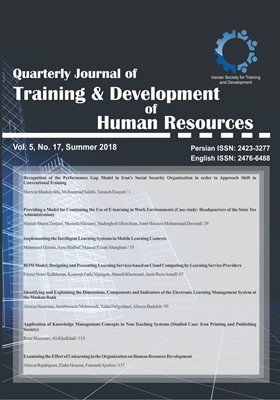-
-
List of Articles
-
Open Access Article
1 - Designing Talent Management Model in Banking Industry
allahvirdi habibpoor Arian Gholipour Gholamreza Memarzadeh -
Open Access Article
2 - Human Resources Training and Development as an Academic Discipline: Experiences and Perspectives
Davood Ghorooneh Fateme Sanaeipour Kobra Emami -
Open Access Article
3 - Identifying the Dimensions and Components of Training Based on Lean Thinking in Social Security Organization
Fatemeh Manoochehri Parivash Jaafari Nadergholi Ghorchian Amir Hosein Mohammad Davoudi -
Open Access Article
4 - Investigating the Role and Importance of Chief Knowledge Officers in Knowledge Management Development from the Point of View of Faculty Members (Case Study: Shahid Beheshti University)
Mahmoud Haghani Mahmoud Abolghasemi Elaheh Seyedmirza -
Open Access Article
5 - Investigating Individual Factors Affecting Transfer of learning Employees in the Municipality of Tehran
Maryam Hassanpour Roodbaraki Mojgan Abdollahi Alireza Araghieh Fatemeh Parasteh-Ghombavani -
Open Access Article
6 - The Study of Challenges in Higher Education System performance with an Emphasis on Human Resource Development
Negin Falah Haghighi Maryam Mahmoudi -
Open Access Article
7 - A Comparative Study on the Missions and Methods of Training in Professional Development Centers in the World Top Universities.
بتول جمالی زواره Ahmadreza Nasr Esfahani Mohammad reza Nili
-
The rights to this website are owned by the Raimag Press Management System.
Copyright © 2017-2025







